
 |
AC Propulsion tZero |
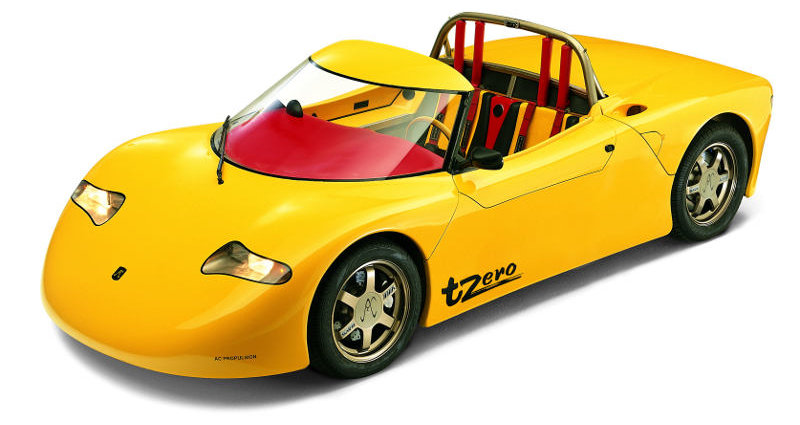 AC Propulsion tZero
AC Propulsion tZeroBefore we get to the main subject, let's start with a little EV background. You can skip this part if you know your EV history well.
For a long time, lots of folks thought that EVs were always slow and boring. Some still do. I think the main reason is that the EVs they knew were golf cars and forklifts. But those aren't slow because they're electric, they're slow because they're golf cars and forklifts. That's their job. Gas-powered golf cars and forklifts are slow too.
It's always been possible to make an EV at least as fast as any ICEV (internal combustion engine vehicle). In 1899, when early gas-powered cars were spooking horses with their 30 km/h (20 mph) speeds, the first car to break the 100 km/h (60 mph) barrier was electric. It was called La Jamais Contente ("The Never Satisfied"), and was built by the Belgian electric vehicle maker and race car driver Camille Jenatzy.
From the late 1950s to the first decade of the 21st century, various factory-made or factory-converted EVs found homes with drivers seeking fume-free mobility. They included the 1959 Henney Kilowatt; the tiny bug-eyed, doorstop-shaped 1974-82 Citicar and Comuta-Car; several 1980s and 1990s pro conversions of various ICEVs; pokey street-legal golf cars bearing the NEV (Neighborhood Electric Vehicle) designation; and a few ill-fated cheap EVs imported from China.
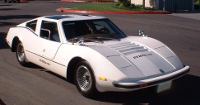 1980 Bradley GTE
1980 Bradley GTEThere's a rule of thumb that applies to any vehicle, but especially to EVs: go fast, go far, go cheap - pick any two. The small businesses that built most of the more-or-less production EVs above reckoned that their cars needed enough range to be reasonably practical for the person driving them to work daily, and priced so that working person could afford them. There you have it: go far + go cheap. Go fast got deep-sixed, even for such sexy-looking EVs as the swoopy gull-wing Bradley GT Electric.
Home-built EVs and conversions were usually pretty modest performers too, but not always. Folks stuffing batteries and motors into gutted ICEVs balanced the go fast - go far - go cheap milking stool in their own ways. Back in the early days of the EVDL, our members built everything from practical commuters to tire-smoking dragsters.
That brings us to 1990 and the General Motors Impact. The Impact wasn't slow. It could hop from 0 to 100 km/h (0-60 mph) in a quite respectable 8.5 seconds. The Impact, and its spawn the GM EV1, did a fair bit to vaporize the golf-car-and-forklift EV image.
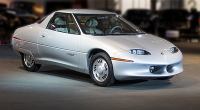 1990 GM Impact
1990 GM ImpactLike GM's earlier experiments with EVs, the Impact was supposed to be a "technology demonstration." They weren't serious about producing it, or any EV, for that matter. But GM made a tactical error: they featured the Impact at the 1990 Los Angeles Auto Show.
Also at the show: members of the California Air Resources Board (CARB), the regulators in charge of cleaning up California's air. One look at that sleek EV told them that GM had been blowing smoke for years, swearing that EVs weren't practical. The story goes that a GM executive at the show turned to a CARB rep and asked, "You're not going to make us build that car, are you?"
Well, as a matter of fact ...
 GM's EV1 Graveyard
GM's EV1 GraveyardGM pitched a fit, eventually filing suit against California. But they did build that car, as the EV1. Not many, something over 1,000. And they didn't sell them. They leased them to a few lucky motorists, who actually had to fill out paperwork to qualify for it.
The drivers loved their EV1s. When the leases were up, many wanted to keep them. Nope! Not for sale, not at any price, and a few lessees made pretty extravagant offers. GM dismissed them all. Except for a scant few EV1s that they disabled and donated to museums and universities, GM hauled them all off and crushed them.
But that wasn't GM's only role in this play.
Around the time that GM gave the green light to the EV1 project, one of the Impact's principal engineers decided that his future wasn't with General Motors, and left GM to start his own EV components company. He designed a high-powered AC drive system - motor and inverter - for EVs. In 1997, not long after GM introduced the EV1, Alan Cocconi and his collaborator, engineer and race driver Tom Gage, fitted that drive system to a handsome fiberglas body. Thus was born an all-out performance electric sports car that also happened to be highly efficient.
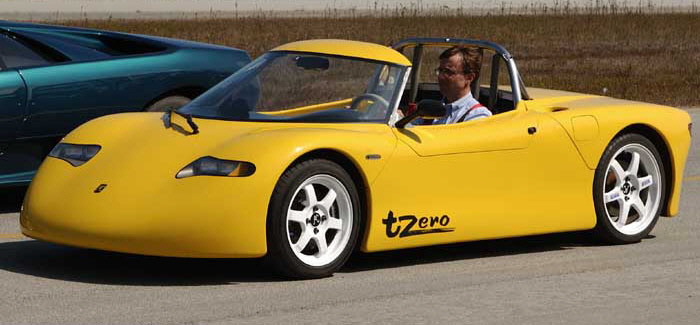 AC Propulsion tZero
AC Propulsion tZero
| AC Propulsion tZero | 1997 (Lead Battery) | 2003 (Lithium Battery) |
| Battery Voltage | 336 volts | ? |
| Battery Capacity | 15 kWh | 47 kWh (est) |
| Battery Weight1 | 570 kg (1250 lb) | 290 kg (645 lb) |
| Battery Specific Energy | 26 Wh/kg | 162 Wh/kg |
| Min Charging Time | 60 min | ? |
| Max Motor Power | 150 kW | 150 kW |
| Curb Weight | 1040 kg (2290 lb) | 895 kg (1970 lb) |
| Power/Weight | 0.14 kW/kg | 0.17 kW/kg |
| Top Speed | 145 km/h (90 mph) | 170 km/h (105 mph) (governed) |
| Range | 140 km (85 mi) | 480 km (300 mi) |
| Efficiency | 11.2 kWh/100 km (180 Wh/mi) | 9.9 kWh/100 km (160 Wh/mi) (est) |
| Price | US$80,000 | US$220,000 |
| Price (inflation-adjusted) | US$147,000 | US$354,000 |
GM had put appreciable effort into making their Impact light, with exotic materials, even low-mass seats. But all up, at 1040 kg (2290 lb), the tZero weighed 23% less than the Impact. Thanks to the low weight, a torquey AC drive, and sophisticated electronic traction control, it left GM's Impact and EV1 in the dust with a 0-100km/h (0-60mph) time of just over 4 seconds.
In 2003 the tZero got a new, much lighter lithium battery, assembled from 6,800 (yep, six thousand eight hundred) 18650-type laptop computer cells. In all, those cells weighed about 280 kg (615 lb) less than the lead they replaced, but the car's curb weight fell by only about 145 kg (320 lb).3 I haven't been able to find any official explanation of that stray 135 kg. My guess is that at least part of it went into the extra hardware required to package and interconnect that eye-watering number of cells, and a no doubt more complex battery management system (BMS) to keep the lithium battery safe and reliable.
At any rate, the lithium battery's lower weight and higher power took the tZero's 0-100km/h time down to 3.7 seconds. It was impressively quick in the midrange too, blasting from 50km/h (30mph) to 80km/h (50mph) in about 1.5 seconds. Cocconi promised an eye-opening range of "up to" 480km (300mi), but probably not if you did very many of those 3.7 second hammer-drops.
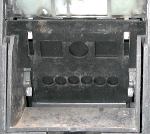 Early Avcon charging port
Early Avcon charging portCharging at up to 20kW was carried out via an early Avcon conductive AC power connector, a forerunner of the SAE J1772 power inlets used on today's production EVs. The AC Propulsion "reductive" charger was bidirectional, able to push stored energy back out to the electrical grid when necessary.
The prices quoted in the specs block above are more speculative than real. The tZero could have been - arguably, should have been - a production car. But in all, only 3 copies of the tZero were ever built, and one of them stayed with AC Propulsion.
Something happened with one of those 3 that probably accelerated more than its owner - it accelerated the adoption of EVs, at least in the US, if not in the world.
In 2003, Tom Gage was in the process of converting his own lead-battery-powered tZero to a lithium battery. Entrepreneur Martin Eberhard, intrigued by the idea of EVs, caught wind of Gage's project and contacted Gage about it. Remarkably, the trusting Gage lent Eberhard his completed lithium tZero to test for 3 months.
Eberhard was impressed. He wanted a tZero of his own. He tried to persuade Cocconi and Gage to put the tZero into production, but they didn't have the funding, and they didn't think that it would sell with their breathtaking US$220,000 price tag on it. Maybe they were right. Instead they embarked on a US$70,000 (inflation-adjusted: US$97,000) conversion of the relatively conventional subcompact Scion xB - and thus missed out on being an even larger part of EV history.
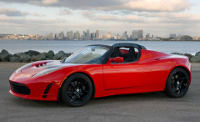 Tesla Roadster Mk I
Tesla Roadster Mk INow, Martin Eberhard is a fairly wealthy guy. His net worth as of 2022 is around US$500 million. In my admittedly limited experience, rich guys aren't keen to hear "no" when they want something. Eberhard decided to take matters into his own hands.
The company that he and Marc Tarpenning founded in 2003 reverse-engineered AC Propulsion's drive and dropped it into a Lotus Elise glider. They thus developed - and put into production - a lithium-powered high-performance open EV with acceleration that rivaled the tZero's, even though it was 81% heavier. The new flip-top car's range was 395 km (245 mi) and its top speed was 200 km/h (125 mph). Possibly as a result of falling prices for lithium cells, at its 2008 introduction it sold for around US$100k to $125k (inflation-adjusted: US$140k-$175k). That's a long way from cheap, but it's not out of line as high performance sports cars go, and it's about half of what Cocconi and Gage had projected 5 years before.
Eberhard's new business? Tesla Motors. The first EV that Tesla built was the original Roadster (2008-2012). The Tesla Roadster led to the Tesla Model S, and eventually to the Model 3, today one of the world's best selling EVs.
Tesla's success lit a competitive fire under the world's other automakers, and it made an even more critical difference: as the Impact had with California's regulators in 1990, Tesla's cars showed Europe's governments that EVs are both practical and inevitable. As I write this, the EU has just passed legislation banning sales of new passenger ICEVs from 2035.
Would EVs have made that much progress that quickly had Alan Cocconi and Tom Gage not built the tZero? It's tough to say. I think that EVs would still have moved ahead, thanks to the vision of Nissan / Renault's controversial former VIP manager Carlos Ghosn in developing the Nissan Leaf and the Renault Zoe. Volkswagen's infamous "Dieselgate" turned out to be a boost for EVs too, especially in Europe.
That said, I'm not so sure that today's best EVs would be as capable as they are without Tesla leading the way. And that almost certainly wouldn't have happened without AC Propulsion's t-Zero.
Note 1: Weight of Optima modules and 18650 cells only. Doesn't include interconnecting hardware, retaining structure, or BMS.
Note 2: You'll find sources that credit security equipment manufacturer Johnson Controls for the tZero Mk I's Optima battery modules. That's not quite accurate. When the first tZero was built, Optima was owned by the Norwegian electronics firm Gylling Teledata A/S. Optima batteries were then a prime choice for EV hobbyists looking for high-power batteries. Johnson Controls purchased Optima in 2000 and subsequently terminated essentially all of Optima's testing, research, and development personnel. How can I say this delicately? How about: the changes in Optima batteries that followed probably accelerated EV hobbyists' adoption of lithium EV batteries.
Note 3: Cocconi and Gage gave the media two different numbers for the lithium battery weight savings, 500 and 700 lb. They also stated the tZero curb weights as 1040 kg (2290 lb) (lead) and 895 kg (1970 lb) (lithium). I'm using the curb weight numbers here.